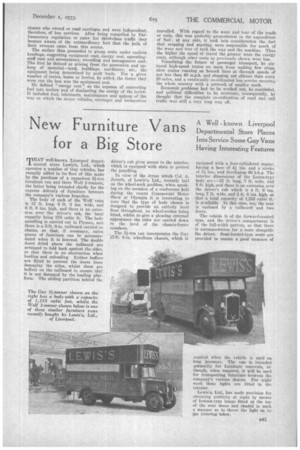The Economics of Transportation
Page 62

Page 63

If you've noticed an error in this article please click here to report it so we can fix it.
Suggestions for the Co-ordination of Road and Rail Transport, Based on an Analysis of their Fundamental Differences
IN a long paper read before members of the Business Research and Management Association recently, Mr. P. C. Young, of the Sentinel Waggon Works, Ltd., Shrewsbury, offered what he described as a few suggestions on the method of approach that might possibly be adopted if any body of men set itself to evolve a complete economic theory for the co-ordination of road and rail transport. He considered that the most practical method of approach was first to take the hest economic solution and, secondly, to try to overcome the political difficulties.
He believed the fundamental principles affecting the approach were equally appropriate for the co-ordination of any two forms of transport, for the essential business of both road and rail transport Was to convey in wheeled vehicles on a prepared way passengers and goods between different pairs of points. He thought that every difference between the two forms of transport arose out of the facts that, on the road, the vehicles were left free to choose their own paths over the whole of the prepared way, whereas on the railway they were restricted by mechanical means to a defined course.
Continuing logically, he found that the road was, accordingly, superior for the control of movement without ground regulation, for quick stopping, starting, turning and independent movement of units. Onthe other hand, requiring ground regulation, the railway was suitable for high speed, bigger consignments of traffic, greater weights and longer distances.
B44 Reverting for the moment to the time when railways were first laid out, he stated that speeds now possible on the road were five times what they were then and costs onefifth of their figure about 100 years ago. The first aim of the supposed co-ordinating body, he assumed, would he to provide services of which the value, to probable users, less the aggregate cost of production, would reach a maximum.
Proceeding to discuss how values and costs might be brought into the best possible relation, Mr. Young divided the services into four "elements "—to use his own term. These were point-to-point movement, terminal services, transport services, and junction and sorting services. The first of these, he said, was, strictly speaking, an abstraction and suggested that acceleration and retardation should really be included in "terminal services." In illustration of this point he informed his audience that a short stopping train burns much more coal per mile than an express.
The main purposes of "transport services" and "junction and sorting services," be explained, were to reduce the cost of the first two; neither one nor the other was an end in itself, and neither was of value to the passenger or to the consignor of goods. As examples of inadequate transfer arrangements between road and rail, he pointed to the principal termini in London and the distances passengers had to walk from train to bus. In explanation he reminded those present that the railways were originally designed to eater for the wealthy classes who owned or used carriages and were independent, therefore, of bus services. After being compelled by Parliamentary regulation to cater for third-class traffic they became aware of the extraordinary fact that the bulk of their revenue came from this source.
The author then proceeded to group costs under various headings, suggesting equipment cost, energy cost, operatingstaff cost and accountancy, recording and management cost. The first he defined as arising from the possession and upkeep of material—land, buildings, machinery. etc., the equipment being determined by peak loads. For a given number of trains, buses or lorries, he added, the faster they were run the less was the equipment cost.
He defined "energy cost" as the expense of converting fuel into motion and of dissipating the energy of the latter. It included fuel, lubricants, maintenance and upkeep of the way on which the motor vehicles, carriages and locomotives travelled. With regard to the wear and tear of the roads or rails, this was probably proportional to the expenditure of fuel ; at any rate, it took into consideration the fact that stopping and starting were responsible for much of the wear and tear of both the way and the machine. Thus the higher the speed of travel the greater were the energy Costs, although other costs as previously shown were less.
Visualizing the future of passenger transport, he pictured high-speed trains on main fines making few stops. slow trains running on branch lines at through speeds of not less than 40 m.p.h. and stopping not oftener than every 20 miles, and a continually co-ordinated bus service covering the whole country with a network of smaller mesh.
Economic problems had to be worked out, he concluded, and political difficulties to be overcome, consequently, he thought that the complete co-ordination of road and rail traffic was still a very long way off.




































































































